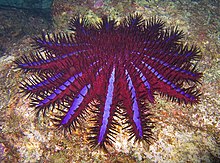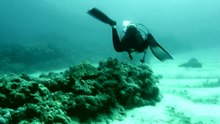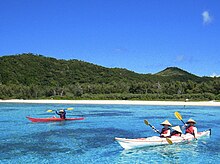Keramashoto National Park
|
Keramashotō National Park
慶 良 間 諸島 国立 公園 |
||
|
View of Zamami-jima from Mount Takatsuki |
||
| location | Okinawa Prefecture , Japan | |
| surface | 35.2 km² (land area), 904.75 km² (water area) | |
| WDPA ID | 555621337 | |
| Geographical location | 26 ° 12 ' N , 127 ° 19' E | |
|
|
||
| Setup date | March 5, 2014 ("Coral Day") | |
| administration | Ministry of Environment | |
| particularities | Smallest national park in Japan by land area | |
The Keramashotō National Park ( Japanese 慶 良 間 諸島 国立 公園, Keramashotō Kokuritsu Kōen ) is a Japanese national park in Okinawa Prefecture , which extends over the Kerama Islands ( Kerama-shotō ) and their surrounding marine areas. The 31st National Park was founded on March 5, 2014, the annual "Coral Day" (サ ン ゴ の 日sango no hi ), as a spin-off from the Okinawa-Kaigan Quasi-National Park .
Park area and protection zones
The Keramashotō National Park is with a total area of 940 km², which is divided into 905 km² (96.3%) water and only 35 km² (3.7%) land area, the smallest national park in Japan by land area. It is classified with IUCN Protection Category II and is administered by the Japanese Ministry of the Environment . The park area is divided into “specially protected”, “protected”, “ordinary” and “ marine protected areas” .
Main islands of the Keramashotō National Park (red: inhabited, green: uninhabited) |
The area of the national park includes all Kerama Islands. The larger islands of the archipelago are Tokashiki-jima , Zamami-jima , Aka-jima , Yakabi-jima , Kuba-shima , Geruma-jima , Fukaji-jima , Amuro-jima , Maeshima and the northeast Keise Islands . Only the four islands Tokashiki-jima, Zamami-jima, Aka-jima and Geruma-jima are inhabited. Kerama Airport is also located on Fukaji-jima . The larger villages of Zamami on Zamami-jima and Tokashiki on Tokashiki-jima together have fewer than 2000 inhabitants.
A marine area of 353 hectares was designated as a Ramsar area on November 8, 2005 . The area was divided into 120 hectares west of Tokashiki-jima Island and 233 hectares between Zamami-jima and Aka-jima. With the establishment of the Keramashotō National Park on March 5, 2014, the Ramsar area was also expanded to include part of the national park and a total area of 8290 ha. It is divided into a total of 10 non-contiguous zones around the individual Kerama Islands.
History, geography and climate
In the 15th century was built on the Ryukyu Islands , the Kingdom of Ryukyu . In 1879 the northern part of the islands and later the southern group became part of the Japanese prefecture of Okinawa. During the Second World War , the first US troops landed on the Kerama Islands from March 26, 1945 before the Battle of Okinawa . More than 600 residents previously committed suicide, 234 of them on Zamami-jima and 330 on Tokashiki-jima. After the war, the islands served as a missile base and, like the rest of the Ryūkyū Islands, were under US military administration before being returned to Japan in 1972.
The Kerama Islands were once connected to the mountains of the main island of Okinawa. Due to the earth's crust movements, however, the land subsided, so that today's archipelago was formed from small islands. The mountainous landscape forms cliffs in some places that reach a height of 100 to 200 m. The area consists mainly of crystalline schist , phyllite and sandstone from the Paleozoic and Mesozoic Era . The water depth in the coral reefs is a maximum of 59 m.
The Kerama Islands are located in the subtropical climatic zone. The water temperatures are lowest in February to March, but do not fall below 20 ° C on an annual average. The maximum temperatures are reached in July to August with 27.1 to 29.6 ° C. The annual average temperature is 21 ° C and the annual rainfall is 2122 mm. The rainy season lasts from May to mid-June. The region is regularly hit by typhoons from summer to autumn and by monsoon winds in winter .
Land flora and fauna
Over 620 species of native plants are found on the Kerama Islands, including 46 different tree species. Fan palms , tree ferns, and ryukyu pines are particularly widespread. Rhododendrons of the red flowering species Rhododendron scabrum adorn the islands in spring and various types of hibiscus in late summer.
Numerous butterflies such as the white tree nymph can be observed. On the islands, some rare species such as the life of the IUCN as endangered classified Ryukyu flying fox , the Samtkehlnachtigall , the highly endangered sword-tail newt and several endangered to critically endangered subspecies of Okinawa clawed geckos .
Tokashiki-jima is next to Okinawa and Kume-jima one of only three islands on which the endangered terrestrial Japanese pointed turtle (Japanese琉球 山 亀 Ryūkyū-yamagame ) is widespread.
Kerama deer also live on four of the islands (Yakabi-jima, Geruma-jima, Aka-jima and Fukaji-jima) . This subspecies of the sika deer, designated as a natural monument , was probably introduced from Kyūshū in the 17th century . Compared to their closest relatives on Kyūshū, the Kerama deer have smaller heads and shorter antlers, but are genetically little different from them. The uninhabited islands Yakabi-jima and Keise islands are also home to numerous bird species such as the potentially endangered classified violet dove and the common tern . Especially in summer you can watch numerous migratory birds such as the Feuerliest on the islands . In autumn, the gray-faced buzzard (Japanese差 羽 Sashiba ) moves to the Kerama Islands.
Coral reefs
ecology
The coral reefs are of the fringing reef type and rich in reef-forming coral colonies in various forms. Over 248 hermatypical coral species from 59 different genera and 14 families were identified. Thus 62% of the reef-forming coral species occurring in Japan are represented in the Keramashotō coral reef. Especially hard corals of the species-rich genus Acropora can be found west of Tokushiki-jima. These have the opportunity to reproduce asexually , for example by driving pieces broken off by the impact of waves to a favorable settlement area, where they continue to grow and form a new colony. Even coral larvae drift after coral spawning in June until the coast Okinawa Hontōs.
Around 360 vertebrates such as tropical fish species live in the coral reef ecosystem , including butterfly fish such as the potentially endangered chevron butterfly fish , wrasse and typical damselfish such as anemonefish . There are also 1640 species of invertebrates including corals and 220 species of algae . Even moray eels , conger eels , groupers , snappers , parrot fish and gobies spawn in the coral reef and use this as a source of food and of rearing their offspring. In addition, the by IUCN as is endangered potentially classified Halbgebänderte Plattschwanz , an aquatic living poisonous snake , and due to its low reproduction rate highly endangered giant Manta common in coral reef. Vertebrates also include endangered species of tortoise such as the endangered loggerhead turtle , the critically endangered hawksbill sea turtle and the endangered green sea turtle . The latter migrates to the sandy beaches of the Kerama Islands in summer to lay eggs. Humpback whales can also be seen around the Kerama Islands, especially from December to April . The 13 to 15 m tall animals spend the summer in the Arctic Ocean and migrate thousands of kilometers south in autumn, where they can then also be found in the subtropical waters around Okinawa. They stay there for the winter while they give birth and raise their young.
Threats

The crown-of-thorn starfish poses a threat to coral reefs , because a single starfish eats several square meters of stony coral every year. A particularly devastating occurrence of crown of thorns starfish occurred in the 1970s and also in autumn 2001. Volunteers among the islanders have therefore been actively fighting the starfish species since 2001 during regular dives.
In addition to the crown of thorns starfish and divers, the rising sea temperatures as a result of man-made global warming are also damaging the coral reefs. Stony corals live in symbiosis with zooxanthellae , which supply them with nutrients, remove pollutants and, among other things, are also responsible for the color of the corals. If the temperature of the seawater is too high - the threshold varies depending on the species, but is usually around 29 ° C - the zooxanthellae can no longer carry out photosynthesis due to photoinhibition , during which the pigment system is over saturated with energy . Instead of oxygen , reactive oxygen compounds are produced that have a toxic effect on the corals. As a result, these repel the zooxanthellae and coral bleaching occurs . The corals will die from the resulting nutrient deficiency if the zooxanthellae do not return within about eight weeks. The rather delicate corals of the genus Acropora , which are widespread in the Keramashotō coral reef, are among the more temperature-sensitive corals. They suffered particularly devastating coral bleaching in 1998. In a study in autumn of the following year, more than 90% of the corals were bleached in 4 out of 15 locations within the coral reefs.
tourism
The clear, warm water of the coral reefs, known as the azure “Kerama Blue” in sunny weather, is popular with divers and snorkelers . About 80% of the islanders live from diving tourism. Sea kayaking , stand-up paddling , glass-bottom boat tours and whale watching are also available for tourists . Hikers offer numerous viewpoints on the mountains and cliffs of the islands all year round a view over the archipelago. Humpback whales can also be observed from there in winter.
Web links
- Keramashoto National Park. Japanese Ministry of the Environment, accessed April 2, 2021 .
- Map of the Keramashoto National Park. (PDF 1.3 KB) Japanese Ministry of the Environment, accessed April 2, 2021 .
- Keramashoto National Park. Japan Travel, accessed April 3, 2021 .
- Kerama Islands. Keramaislands.asia, accessed April 2, 2021 (English).
- Keramashoto Coral Reef. (PDF 224 KB) Japanese Ministry of the Environment, accessed April 1, 2021 .
Remarks
- ↑ Weather average data Tokashiki 1979-2000
Individual evidence
- ↑ 慶 良 間 諸島 国立 公園 の 指定 に つ い て. Okinawa Prefecture, archived from the original on June 6, 2014 ; Retrieved March 13, 2019 (Japanese).
- ↑ a b c d e Characteristics of Keramashoto National Park. Japanese Ministry of the Environment, accessed April 3, 2021 .
- ↑ Keramashotō National Park in the World Database on Protected Areas (English)
- ↑ a b c Map of the Keramashotō National Park with marine protected areas. (PDF 1.3 MB) Japanese Ministry of the Environment, accessed April 2, 2021 .
- ↑ a b Keramashoto Coral Reef. (PDF 224 KB) Japanese Ministry of the Environment, accessed April 1, 2021 .
- ↑ 10 zones of Keramashoto Coral Reef Ramsar Site. (JPG) Ramsar Sites Information Service, accessed April 2, 2021 .
- ↑ Kerama Islands echo with WW2 tragedy. Independent Online, May 14, 2015, accessed May 14, 2021 .
- ↑ a b c d e f Information Sheet on Ramsar Wetlands (RIS). (PDF 255 KB) Ramsar Sites Information Service, accessed April 1, 2021 .
- ↑ a b The Official English Guide to Zamami Village. Zamami Tourist Information, accessed April 2, 2021 .
- ↑ a b Cervus nippon keramae. National Research and Development Agency, National Institute for Environmental Studies, accessed April 2, 2021 .
- ↑ a b Keramashoto National Park. Japan Travel, accessed April 3, 2021 .
- ↑ a b c d Keramashoto National Park, Guide of Highlights. Japanese Ministry of the Environment, accessed April 3, 2021 .
- ↑ Nature of Kerama Islands. Keramaislands.asia, accessed April 3, 2021 .
- ↑ Pteropus dasymallus in the endangered Red List species the IUCN 2017. Posted by: Vincenot, C., 2017. Accessed May 11, 2021st
- ↑ Cynops ensicauda in the endangered Red List species the IUCN 2021. Posted by:. IUCN SSC Amphibian Specialist Group, 2021. Retrieved on 11 May 2021.
- ↑ Goniurosaurus orientalis in the endangered Red List species the IUCN 2017. Posted by: Kidera, N. & Ota, H., 2017. Accessed May 11, 2021st
- ↑ Goniurosaurus yamashinae in the Red List of Threatened Species of the IUCN 2017. Posted by: Kidera, N. & Ota, H., 2017. Accessed May 11, 2021st
- ↑ Geoemyda japonica in the endangered Red List species the IUCN 2000. Posted by: Asian Turtle Trade Working Group, 2000. Accessed May 11, 2021st
- ↑ Columba janthina in the endangered Red List species the IUCN 2016 Posted by: BirdLife International, 2016. Accessed May 11, 2021st
- ↑ Keramashoto National Park. Japanese Ministry of the Environment, accessed April 2, 2021 .
- ^ MOE National Parks of Japan Keramashoto National Park Tokashiki, Zamami. Japanese Ministry of the Environment, accessed April 5, 2021 .
- ↑ a b Ramsar Information Sheet (29 May 2015), Japan Keramashoto Coral Reef. (PDF 2.4 MB) Ramsar Sites Information Service, accessed April 1, 2021 .
- ↑ Chaetodon trifascialis in the endangered Red List species the IUCN 2010. Posted by: Carpenter, KE & Pratchett, M., 2010. Accessed May 11, 2021st
- ↑ Laticauda semifasciata in the endangered Red List species the IUCN 2010. Posted by: Lane, A. & gatus, J., 2010. Accessed May 11, 2021st
- ↑ Mobula birostris in the endangered Red List species the IUCN 2020 Posted by: Marshall, A. Barreto, R., Carlson, J., Fernando, D., Fordham, S. Francis, MP, Derrick, D., Herman, K., Jabado, RW, Liu, KM, Rigby, CL & Romanov, E., 2020. Retrieved May 11, 2021.
- ↑ Caretta caretta in the endangered Red List species the IUCN 2017. Posted by: Casale, P. & Tucker, AD, 2017. Accessed May 11, 2021st
- ↑ Eretmochelys imbricata in the endangered Red List species the IUCN 2008. Posted by: Mortimer, JA & Donnelly, M. (IUCN SSC Marine Turtle Specialist Group), 2008. Accessed May 11, 2021st
- ↑ Chelonia mydas in the endangered Red List species the IUCN 2004. Posted by: Seminoff, JA (Southwest Fisheries Science Center, US), 2004. Accessed May 11, 2021st
- ↑ Whale watching in Okinawa. Visit Okinawa Japan, accessed April 2, 2021 .
- ^ Coral Bleaching and the Great Barrier Reef. (PDF 2.2 MB) Australian Government, Great Barrier Reef Marine Park Authority, accessed April 2, 2021 .









